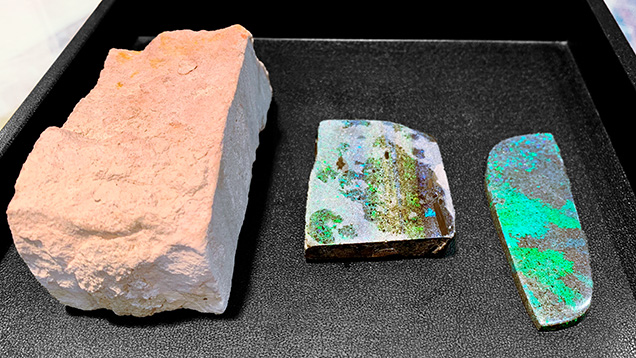Sugar/Heat-Treated Opal

Treatments can cause harm when they are not disclosed properly, but without treatments, fewer gem resources would find their usage in the jewelry trade. At the AGTA show, the authors had the rare opportunity to talk with James Carpenter from Arkansas-based Unconventional Lapidarist about sugar/heat treatment on porous rough opal.
Sugar and acid treatment is one of the most commonly used methods to enhance opal. In the trade, this treatment is usually applied to matrix opal from Andamooka, Australia, a particularly porous material. The finished product is often referred to as “Andamooka matrix opal” or “Andamooka rainbow matrix opal” by the trade. This treatment was presented as a hot sugar bath followed by a hot acid bath (G. Brown, “Treated Andamooka matrix opal,” Summer 1991 G&G, pp. 100–106). The chemical reaction between sugar and acid then deposits carbon to the porous structure of the opal as black dots. The treatment darkens the background color of the opal and therefore makes the play-of-color stand out more.
Carpenter revealed that he treated the opal without using acid to gain a similar result. The opals, either slices or cabochons, were first soaked in a hot 50% sugary water solution for 6 to 9 hours. After cooling down from the hot sugar bath, the pieces were patted dry and then tightly wrapped in aluminum foil. Carpenter emphasized that tight wrapping is especially important because a loose wrap causes the sugar to sweat out and possibly generate more cracks in the material. The well-wrapped materials were then heated in a toaster oven at 450–500°F for about 4 hours. After the final cooling, the materials were polished to finished products or retreated if necessary, revealing a dramatic change from start to finish (see above).
.jpg)


